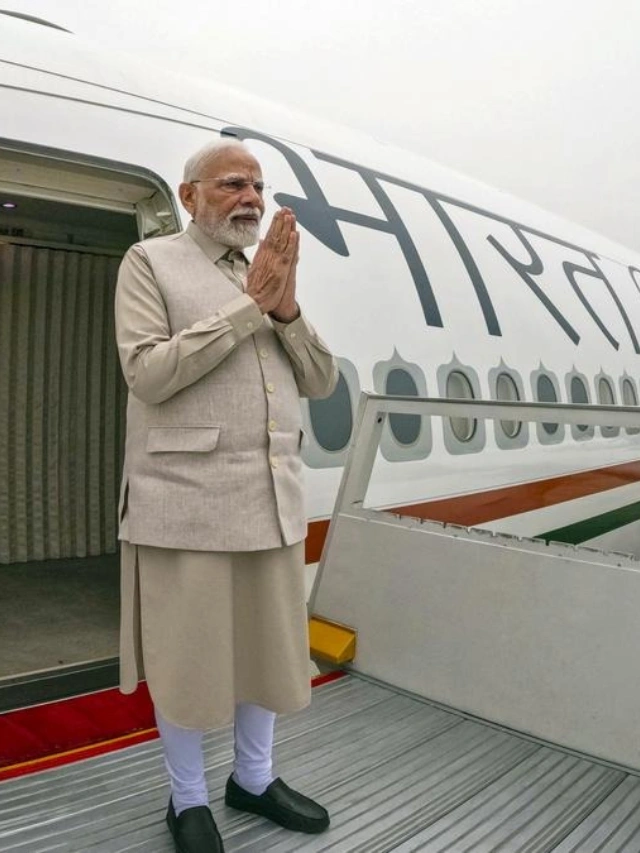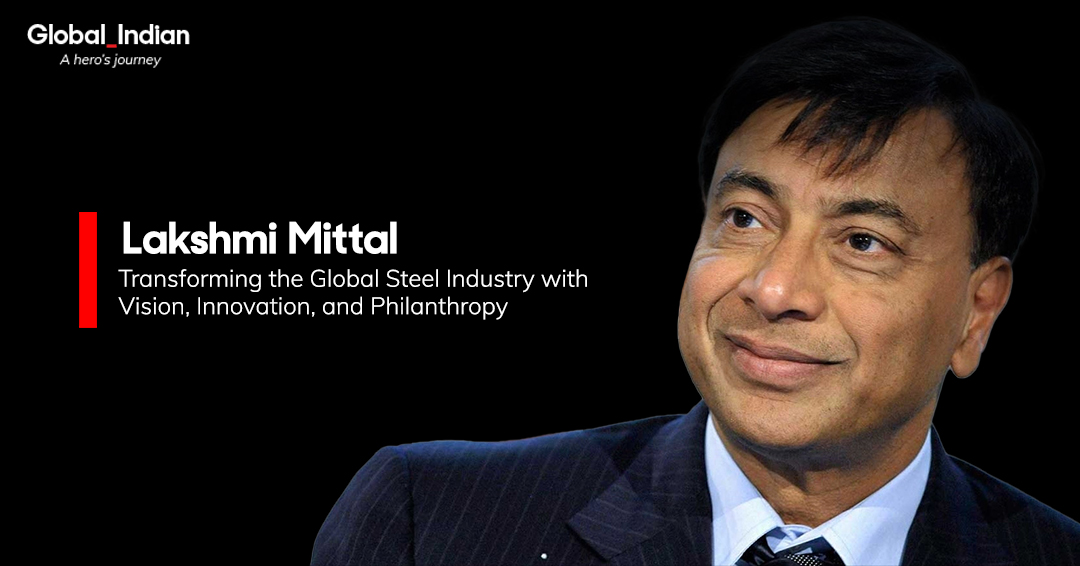
Lakshmi Niwas Mittal
Lakshmi Mittal reshaped the scene when he turned a small Indonesian steel factory into ArcelorMittal, now the world’s second-largest steelmaking company with $68 billion in revenue. His incredible experience in steel started in 1976, and this was just the beginning of his global business empire.
Mittal built everything from the ground up. His business sense and smart acquisitions led to his biggest win – buying Arcelor for $33 billion in 2006. This deal created the world’s largest steelmaking company and established him as a global business leader. His success peaked in 2008 when his net worth reached $45 billion, making him the world’s fourth-wealthiest person.
CEO’s | Actors | Politicians | Sports Stars
Today, Mittal ranks as the 113th richest person worldwide with $16.4 billion. He still shapes the steel industry’s future actively. The company expects steel demand to grow in major markets under new leadership. His son Aditya Mittal took over as CEO in 2021, while Lakshmi stepped into the role of executive chairman to guide the company’s strategy.
“Success is never final. Failure is never fatal. It is the courage to continue that counts.”
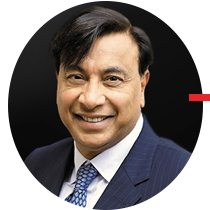
Early Life of Lakshmi Niwas Mittal
Family background in Marwari business community: L.N. Mittal was born on June 15, 1950, in Sadulpur, Rajasthan, to a modest Marwari Hindu family. His childhood was simple. Twenty family members shared a house his grandfather built. They slept on rope beds and cooked on an open fire. His grandfather worked for Tarachand Ghanshyam Das, a leading Marwari industrial firm before India’s independence.
Education at St. Xavier’s College: The Mittal family moved to Calcutta (now Kolkata) during the 1960s to seek better opportunities. Mittal studied at Shri Daulatram Nopany Vidyalaya from 1957 to 1964. His academic excellence faced an unexpected hurdle when St. Xavier’s College rejected his application because of his limited English skills. In spite of that, he convinced the principal by promising to learn English within a year. He kept his word and became fluent in English. His dedication showed results when he earned a difference in his second year and topped the institute in his third year. He graduated with first-class honors in B.Com from St. Xavier’s College, University of Calcutta.
Learning the ropes in his father’s steel mill: Mittal learned about the steel industry at his father Mohanlal Mittal’s company, Nippon Denro Ispat. He balanced his education and work from age 19. His days were split between college classes and evening shifts at the steel mill. After graduating in 1970, he joined the family business as a trainee. This hands-on experience in steelmaking became the foundation for his future success.
St. Xavier’s played a vital role in building Mittal’s confidence to make bold decisions, especially his move to Indonesia in 1976. He later wished he had studied more, but his combination of practical experience and formal education helped him build his future empire.
From India to the World
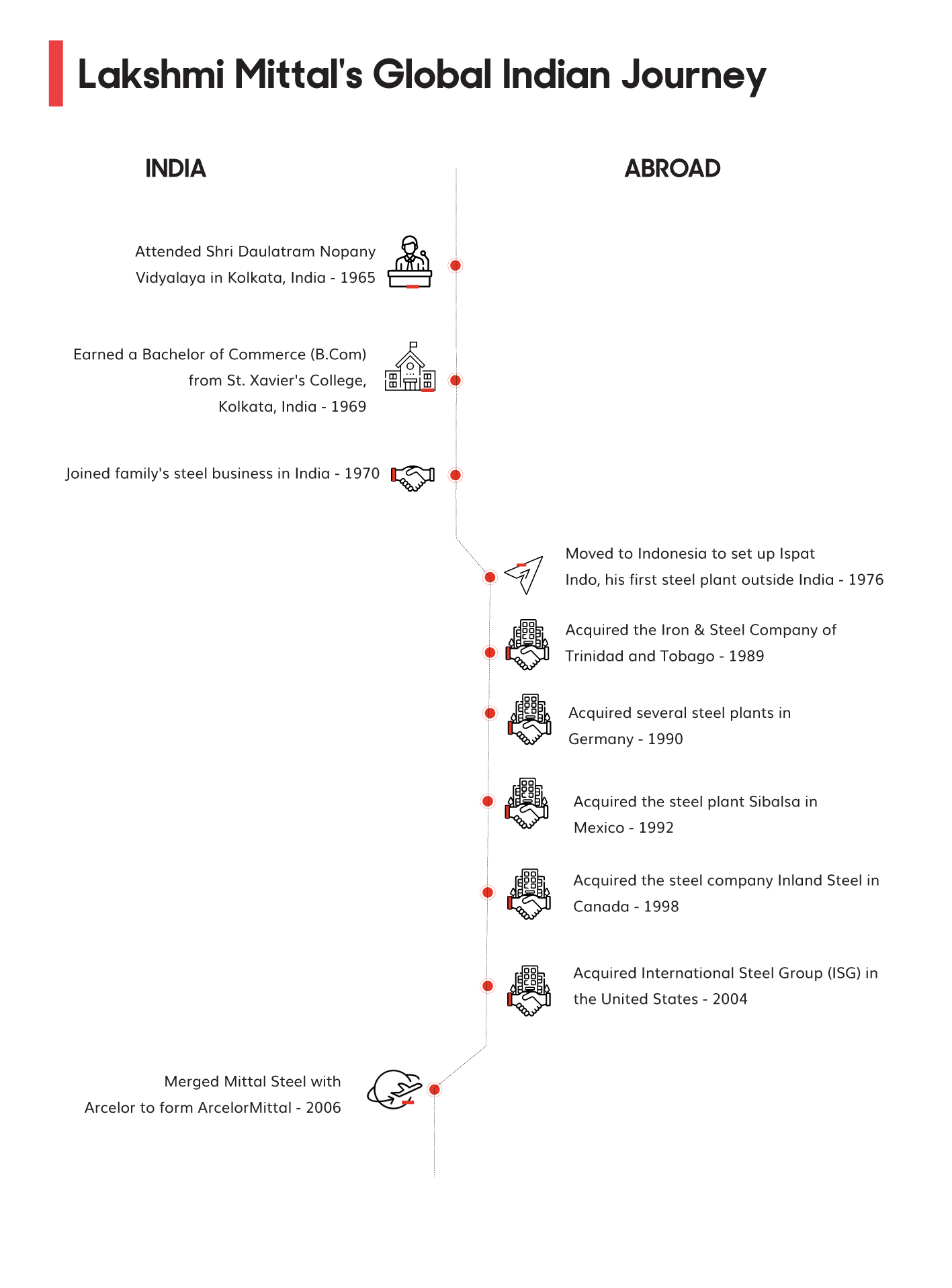
Career Journey: Foundations of a Steel Legacy
The Indonesia Steel Factory
Breaking away from family business in 1976: Lakshmi Mittal saw a chance that would change his path forever at age 26. He chose to build a steel manufacturing facility instead of selling rice paddies in Surabaya, Indonesia. His gut feeling as an entrepreneur pushed him to create PT Ispat Indo in Sidoarjo, East Java. This bold move marked his first step to build his own business empire away from his family’s operations in India.
Challenges of starting from scratch: Starting his Indonesian venture came with many roadblocks. Mittal struggled with his limited knowledge of global markets and the local business world. India’s strict exchange controls made it impossible to export capital directly. Yet, he found a clever solution through an Indian government scheme that allowed:
- Equipment and materials purchase in India
- Export to Indonesia
- Government funding up to 85% of the cost against exports
Early management lessons: Mittal’s approach to the Indonesian market broke new ground. He found a big price gap between local and imported Japanese steel after careful market analysis. This discovery led him to use mini-mill technology – electric arc furnaces fed with enriched iron ore pellets – instead of traditional blast furnaces. This tech choice ended up changing conventional steelmaking methods.
Mittal got the needed permits and electricity supply from Indonesian authorities through persistent talks. His smart approach worked well as the Surabaya plant opened in 1978 and made money right away. He spent the next decade becoming skilled at running plants efficiently. This became his signature strategy: buying struggling steel companies, cutting costs, boosting productivity, and using economies of scale.
The Indonesian venture became the stepping stone for what would later become ArcelorMittal. It showed Mittal’s knack for finding chances where others saw problems. His success in Indonesia gave him the blueprint for future buyouts, starting with Trinidad and Tobago in 1989. This experience shaped his vision of bringing the industry together, which guided all his future business moves.
The Turnaround Specialist: Transforming Failing Steel Mills
Trinidad and Tobago acquisition strategy: Lakshmi Mittal made his first major international move in 1989 by buying the state-owned steel works in Trinidad and Tobago. The facility struggled with huge losses, but Mittal saw hidden value others missed. His strategy targeted underperforming state-run facilities where his management expertise could make a real difference.
Converting losses to profits: within a year Mittal’s team achieved remarkable results by applying modern management practices. The Trinidad and Tobago facility doubled its output and became profitable in just twelve months. This quick turnaround proved Mittal’s ability to breathe new life into struggling steel operations.
Developing the Mittal operational playbook: The Trinidad and Tobago success helped Mittal develop his signature strategy. His approach focused on three key elements:
- Cost Optimization: Mittal’s team at Imexsa in Mexico cut production costs from INR 21,348.25 to INR 15,019.72 per ton. They also boosted productivity by reducing man-hours per ton from 2.62 to 0.97 between 1992 and 1998.
- Quality Enhancement: Imexsa’s product mix changed dramatically under Mittal’s leadership. The company moved from 97% low-grade construction steel in 1992 to 47% high-grade automotive and coated plate applications by 1997.
- Operational Excellence: Mittal brought fresh management practices to his acquisitions:
- Daily performance monitoring and reporting systems
- Complete quality programs
- Global integration initiatives
- Ambitious stretch goals
Results proved this approach worked well. Imexsa’s shipments jumped from 528,000 tons to 929,000 tons in the first year. The facility’s annual steel shipments grew even more impressively from 929,000 tons to over 3 million tons between 1992 and 1998.
Mittal’s management style balanced operational improvements with teamwork. His team created service agreements between departments and tracked delivery against set targets. Departments took ownership of their goals because they helped create them rather than having them imposed from above.
Governments worldwide noticed this operational success. The Mexican government, impressed by the turnaround at Iscoot (the Trinidad facility), invited Mittal’s company to bid for Sicartsa. This pattern continued as struggling steel mills sought his expertise to turn their operations around.
Building the Mittal Steel Empire: Key Acquisitions
Eastern European expansion strategy: Lakshmi Mittal boldly expanded into former Soviet bloc countries during the early 1990s. He bought steel plants in Kazakhstan, Ukraine, and Poland. His smart vision targeted markets where Western investors were hesitant, which let him buy valuable assets at good prices.
Consolidation milestone: A turning point came in 2004 when Mittal combined his two main companies, Ispat International and LNM Holdings. He also bought International Steel Group (ISG) in the United States. This created Mittal Steel Company N.V., which became the world’s top steel producer.
Navigating political landscapes: Mittal tackled complex political hurdles during his expansion. European governments resisted his buyouts because they worried about job cuts and losing control of key industries. The Romanian negotiations stretched into intense 15-hour meetings with 24 chain-smoking government officials. Every detail of these high-stakes talks was carefully documented.
Creating a global footprint: Mittal Steel grew to operate in 14 countries by 2006, with a market value of INR 1712.92 billion. The company’s growth relied on three main strategies:
- Buying struggling assets through privatization programs
- Bringing in modern management methods
- Making operations more efficient
Strategic vision and operational excellence: Mittal led the company with clear priorities:
- Smart management of assets across promising markets
- Working across the entire steel value chain
- Strong presence in both developed and emerging markets
Global reach and impact: The company’s worldwide expansion created a chance to set standards and tap into economies of scale. ArcelorMittal produced various types of steel for different sectors:
- Mobility
- Construction
- Infrastructure
- Industrial applications
- Energy sector
Research and innovation: Mittal invested heavily in research while expanding globally. His team challenged both process and product innovation limits to create smarter steel solutions for changing customer needs. This dedication to innovation and strategic buyouts made the company a technology leader in the industry.
The Arcelor Merger: Creating the World’s Largest Steel Company
The hostile takeover battle: The global steel industry witnessed a historic moment on January 27, 2006, when Mittal Steel launched an unprecedented INR 1583.10 billion hostile bid for Arcelor. This offer stood as the highest in the steel industry’s history and aimed to create a steel giant that would control 10% of global production. Arcelor’s board quickly rejected the bid because their strategic vision and development models didn’t match.
Overcoming European resistance: European stakeholders fiercely opposed the acquisition. Luxembourg, France, and Spain put up strong resistance against the takeover. Arcelor’s management used multiple defense strategies. They transferred their subsidiary Dofasco into a trust and adopted a poison pill strategy. Mittal showed remarkable flexibility by making key concessions:
- Capping his stake under 45%
- Offering 12 of 18 board seats to independent directors
- Agreeing to a 5-year share lock-in period
Integration challenges and solutions: Arcelor finally accepted Mittal’s bid on June 25, 2006, after six months of intense negotiations and an improved offer. The final deal structure reflected everyone’s interests:
- Arcelor investors got 50.5% ownership
- Mittal Steel investors received 49.5% ownership
- Arcelor shareholders received 13 Mittal Steel shares plus euro 150.60 in cash for 12 Arcelor shares
This merger created an unprecedented steel powerhouse. ArcelorMittal emerged as the dominant player in North America, South America, Europe, and Africa. The deal brought synergies worth INR 84.38 billion and altered the map of global steel production.
ArcelorMittal continues to grow under Mittal’s leadership. The company plans to build the world’s largest single-location steel manufacturing site at Gujarat’s Hazira by 2029. This facility will produce 24 million tons of crude steel each year, adding another milestone to Mittal’s legacy of industry leadership.
This merger succeeded despite strong political opposition and cultural differences, highlighting Mittal’s exceptional negotiation skills and strategic vision. The deal created the world’s largest steel company at that time and showed how combining strengths could build an industry powerhouse. Mittal turned a hostile takeover into a partnership that reshaped the global steel industry through careful planning and strategic compromises.
Lakshmi Mittal’s Business Philosophy and Leadership Style
Industry consolidation vision: Lakshmi Mittal led ArcelorMittal to unite and globalize the steel industry model. He focused on finding undervalued assets worldwide and implemented modern management practices to create economies of scale. His systematic acquisitions in North America, South America, Europe, South Africa, and CIS regions altered the industry map.
Crisis management approach: Mittal showed exceptional abilities to handle market downturns. His forward-thinking strategy prioritized long-term investments in technology and infrastructure during economic challenges. ArcelorMittal built a complete crisis response framework that included:
- Daily performance monitoring systems
- Strategic cost-reduction initiatives
- Proactive stakeholder communication
The company managed to keep its position as the world’s leading steel producer, which proved this approach worked. Mittal made swift, decisive decisions based on deep market analysis and operational expertise.
Passing the torch to son Aditya Mittal: A major leadership change happened in February 2021 when Lakshmi Mittal became Executive Chairman and appointed his son Aditya Mittal as CEO. This carefully orchestrated succession built on their teamwork since Aditya joined the company in 1997. Aditya’s achievements stand out:
- CNBC Europe named him ‘European Business Leader of the Future’ in 2008
- Fortune magazine ranked him fourth in their ’40 under 40′ list in 2011
- He serves on boards of ArcelorMittal, Aperam, HMEL, and Iconiq Capital
Aditya proved his worth by playing a key role in the INR 2700.17 billion merger with Arcelor in 2006. His focus now lies on making steel production carbon-free and driving ArcelorMittal’s growth. The company stays on course through:
- A well-defined leadership structure
- Clear governance frameworks
- Strong risk management practices
Lakshmi Mittal still helps shape ArcelorMittal’s future strategy in this new setup. The company’s dedication to innovation shows in its INR 23457.77 million research investment in 2017. A team of 1,400 full-time researchers helps maintain its competitive edge.
Key Achievements
Record-Breaking Financial Performance: Lakshmi Mittal’s leadership drove ArcelorMittal to remarkable financial milestones with revenues of INR 5737.87 billion. The company’s strong financial performance continued steadily, with an operating income of INR 869.12 billion in 2022.
Global Steel Production Leadership: Mittal Steel’s exceptional capabilities shone through in 2006 when it produced 110.5 million tons of steel. The company’s annual production capacity reached 138 million tons. ArcelorMittal now runs steel-making facilities in 16 countries and serves customers in 155 countries.
Strategic Acquisitions: Arcelor and Nippon Steel bought Essar Steel from Shashi and Ravi Ruia for INR 497.84 billion in 2019. This move boosted ArcelorMittal’s Asian market presence. The company had earlier acquired Ukrainian steel manufacturer Kryvorizhstal for INR 405.03 billion in October 2005.
Industry Recognition: Mittal’s career earned him several prestigious awards:
- Fortune magazine named him European Businessman of the Year in 2004
- Financial Times chose him as Person of the Year in 2006
- World Steel Association awarded him their medal in 2010 for his contribution to green industry development
Wealth Creation and Rankings: Forbes ranked Mittal as the third-richest person globally in 2005, making him the first Indian citizen in the top ten. His wealth peaked at INR 3797.12 billion in 2008, making him the fourth-wealthiest person worldwide. Today, his net worth stands at INR 1409.15 billion, placing him 15th on Forbes’ list of India’s richest tycoons.
Environmental Leadership: ArcelorMittal’s commitment to corporate transparency and climate change initiatives earned them an A- rating in CDP’s 2019 Climate Change assessment. The World Steel Association consistently recognized the company with their Steelie Award for Excellence in Sustainability.
Corporate Excellence: ArcelorMittal’s impressive list of industry awards includes:
- Fiat Chrysler Automobiles’ Best Raw Material Supplier in Latin America Award
- General Motors’ Supplier of the Year award multiple years running
- Recognition for their Ebola crisis response in West Africa
Investment and Expansion: The company pledged INR 759.42 billion for investment in Jharkhand, India in 2005. ArcelorMittal also launched a CAD INR 177.20 billion investment program that created 8,000 jobs by expanding the Mont-Wright mining complex.
Impact on the Industry
Market Transformation: ArcelorMittal has altered the global steel map beyond its operations. The company’s research centers worldwide drive innovation in steel products, processes, and solutions. These centers measure new standards for industry practices.
Industry Standards: ArcelorMittal’s strategic integration maintains steel production across multiple sectors:
- Mobility applications
- Construction projects
- Infrastructure development
- Industrial manufacturing
- Energy sector innovations
Global Market Dynamics: The steel market went through substantial changes after 2000. China’s emergence as a major producer shaped these changes. Chinese production capacity grew rapidly with 10-15 new steel plants each year. This growth turned China from a net importer to a net exporter by 2005. The global supply dynamics changed significantly.
Strategic Market Positioning: ArcelorMittal adapts well to market challenges. The company prioritizes:
- Captive mines for competitive steel operations
- Production expansion in Liberia
- Strong presence in geopolitically stable markets
Future Growth Trajectory: ArcelorMittal expects steel demand to grow between 2.5% and 3.5% globally (excluding China) in 2025. The company shows its growth commitment through new investments. A notable example is the steel plant in Calvert, Alabama, which will meet rising U.S. automotive sector demands.
Environmental Leadership: ArcelorMittal guides industry sustainability efforts through:
- Intensified decarbonization initiatives
- Commitment to net-zero emissions
- Sustainable steel development programs
Operational Excellence: The company’s market leadership reflects in its financial performance. Sales reached INR 6736.94 billion in 2022, up from INR 6461.01 billion the previous year. These numbers show ArcelorMittal’s ability to stay profitable despite market changes.
Research and Innovation: ArcelorMittal’s dedicated research facilities consistently create advances in:
- New steel products
- Manufacturing processes
- Industry solutions
These innovations place the company at the vanguard of industry development. They influence global steel manufacturing practices and standards.
Giving Back
Harvard University Endowment: Lakshmi Mittal donated INR 2109.51 million to Harvard University’s South Asia Institute through the Mittal Foundation. The institute now bears his name as the Lakshmi Mittal South Asia Institute at Harvard University. This generous gift shows Mittal’s dedication to academic excellence and regional growth.
Medical Research Support: Mittal made a landmark contribution of £3.2 million to Oxford’s Jenner Institute, which stands as the world’s largest academic vaccine center. His donation helped secure a crucial professorship in vaccinology that drives vital vaccine research. He also funded the Mittal Children’s Medical Center at Great Ormond Street Hospital, which opened its doors in January 2018, showing his commitment to healthcare advancement.
Sports Development: The Mittal Champions Trust, established by Mittal in 2005, helps talented athletes in India reach their full potential. Athletes receive:
- Financial assistance
- Professional training facilities
- Expert mentorship programs
Educational Initiatives: The Mittal family actively supports education throughout India. Their forward-thinking approach helps position the country and region for success through public policy development and academic excellence.
Healthcare Focus: Lakshmi Mittal works closely with his wife Usha Mittal on healthcare philanthropy. Their partnership with UNICEF tackles child malnutrition in India, showing their commitment to solving critical health challenges.
Community Development: ArcelorMittal takes community involvement beyond traditional philanthropy. The company runs impactful community projects where it operates. Their work includes:
- Understanding local needs and effects
- Creating environmental and social programs
- Building local development through partnerships
Corporate Social Responsibility: ArcelorMittal, under Mittal’s guidance, takes a well-laid-out approach to social responsibility. The company invests heavily in community development to create positive change where it operates. Their programs focus on building collaborative, progressive, and green development by helping people reach their full potential.
This detailed philanthropic strategy reflects Mittal’s deep belief in giving back to society. He combines targeted support for institutions with broader community development programs. His approach emphasizes lasting change and measurable results in education, healthcare, and social development.
Also Read: What Lakshmi Niwas Mittal has been up to in 2025 — from global expansions to green innovations.
Key Takeaways
Steadfast Determination: Business success needs resilience when times get tough. Mittal puts it well: “Everyone experiences tough times, it is a measure of your determination and dedication how you deal with them and how you can come through them”.
Strategic Vision: Mittal’s knack for spotting opportunities in overlooked markets is the life-blood of his success. His method of reviving struggling businesses shows the value of strategic cost management and economies of scale. He turned underperforming assets into profitable ventures through calculated risks and fresh thinking.
Adaptability in Leadership: Leaders need a clear mindset to succeed. They must stay composed and grasp their goals as the organization’s face. ArcelorMittal thrived under Mittal’s leadership by adapting to market changes, which proves flexibility and new ideas are vital for lasting success.
Three Pillars of Success: Mittal’s achievements rest on three key attributes:
- Commitment to excellence
- Dedication to goals
- Passion for innovation
Global Impact: ArcelorMittal operates steel production facilities in 16 countries and serves customers in 155 nations. The company’s steel appears in iconic structures worldwide, including:
- One World Trade Center
- Rockefeller Center
- The New New York Bridge
- USS Indiana Navy ships
Innovation Leadership: ArcelorMittal leads the industry with constant innovation and eco-friendly practices under Mittal’s guidance. His dedication to environmental responsibility sets new standards for the global steel sector.
Future Legacy: Mittal’s rise from modest beginnings to building a global steel empire inspires entrepreneurs everywhere. His story shows that big dreams become reality with vision, perseverance, and smart risks. The company shapes steel manufacturing’s future and plans to build the world’s largest single-location steel site at Gujarat’s Hazira by 2029.
Global Indian Impact Analysis
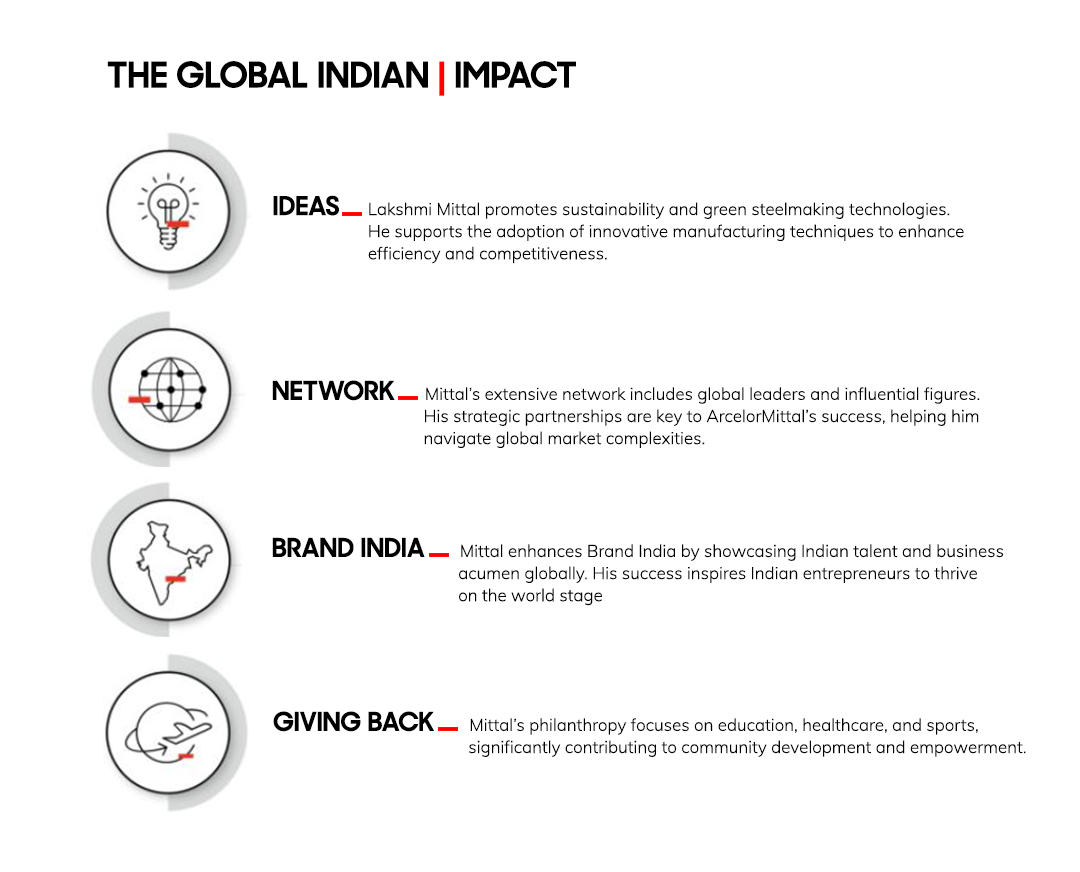
Read a similar story of Jay Chaudhry, successful entrepreneur.
FAQs
What is Lakshmi Mittal’s net worth in 2025?
As of February 2025, Lakshmi Mittal’s net worth is approximately $17.5 billion. He remains one of the wealthiest individuals in India, ranking among the top billionaires globally. His fortune primarily comes from ArcelorMittal, the world’s second-largest steel producer. His net worth fluctuates based on global steel demand, market trends, and company performance.
Who is Lakshmi Niwas Mittal?
Lakshmi Niwas Mittal is an Indian-born steel magnate and the executive chairman of ArcelorMittal. Born on June 15, 1950, in Rajasthan, he transformed his family’s steel business into a global empire. Mittal is known for his strategic acquisitions and innovative approach in the steel industry. He is also a philanthropist, contributing to education and healthcare initiatives.
What is the current share price of Lakshmi Mittal’s company?
As of February, 2025, ArcelorMittal (MT) is trading at $28.98 USD on the New York Stock Exchange (NYSE). The stock price varies depending on global steel demand, raw material costs, and economic trends. Investors closely monitor ArcelorMittal’s stock due to its significant role in the steel industry.
What is Lakshmi Mittal’s company?
Lakshmi Mittal is the executive chairman of ArcelorMittal, the world’s second-largest steel manufacturer. Headquartered in Luxembourg, the company operates in 60+ countries, supplying steel to automotive, construction, and energy industries. It was formed in 2006 after the merger of Mittal Steel and Arcelor. The company focuses on sustainability and innovation in steel production.
Who is Lakshmi Mittal’s daughter?
His daughter, Vanisha Mittal, gained international fame for her extravagant 2004 wedding at the Palace of Versailles in France, one of the most expensive weddings in history. She has been involved in the family business but maintains a low public profile. She is married to Amit Bhatia, an investor and businessman.
What is Lakshmi Mittal’s educational background?
Lakshmi Mittal holds a Bachelor of Commerce (B.Com) degree from St. Xavier’s College, Kolkata. His education in business and commerce helped him develop the strategic vision that led to his success in the steel industry. Although he did not pursue technical degrees, his business acumen has been key to ArcelorMittal’s growth.
What businesses does Lakshmi Mittal own?
Lakshmi Mittal’s business empire includes:
- ArcelorMittal (Global steel manufacturing)
- Aperam (Stainless steel production)
- HPCL-Mittal Energy Ltd. (HMEL) (Oil refining and energy)
- ArcelorMittal Nippon Steel India (Joint venture in India)
- Queens Park Rangers F.C. (QPR) (Football club ownership)
Who is Lakshmi Mittal’s son?
His son, Aditya Mittal, is the CEO of ArcelorMittal. He played a crucial role in the 2006 merger of Arcelor and Mittal Steel and oversees global operations. Under his leadership, the company is focusing on sustainability, innovation, and expanding in emerging markets.
How old is Lakshmi Mittal in 2025?
Lakshmi Mittal was born on June 15, 1950, making him 74 years old in 2025. Despite his age, he remains actively involved in ArcelorMittal’s operations and strategic decision-making.
Who is Lakshmi Mittal’s wife?
Lakshmi Mittal is married to Usha Mittal, who is actively involved in philanthropic activities. She has supported several educational initiatives, including the Usha Mittal Institute of Technology (UMIT) in Mumbai, which promotes women’s education in engineering and technology.



